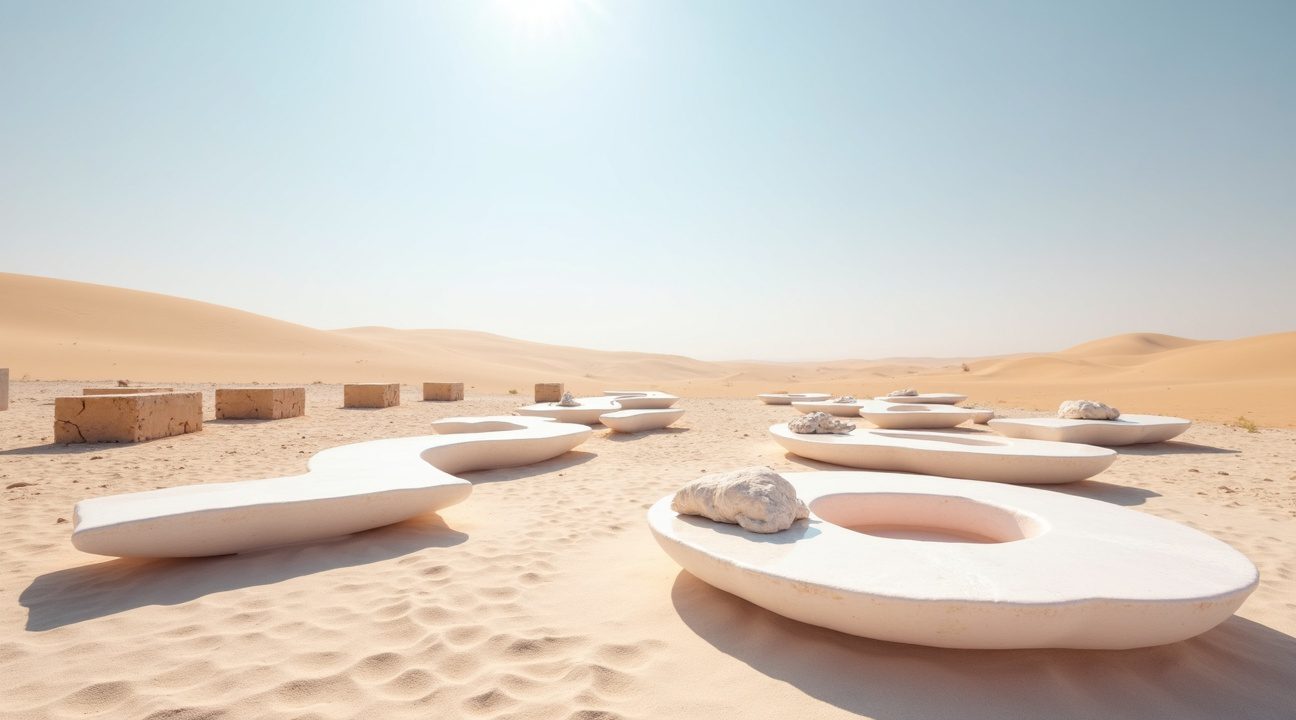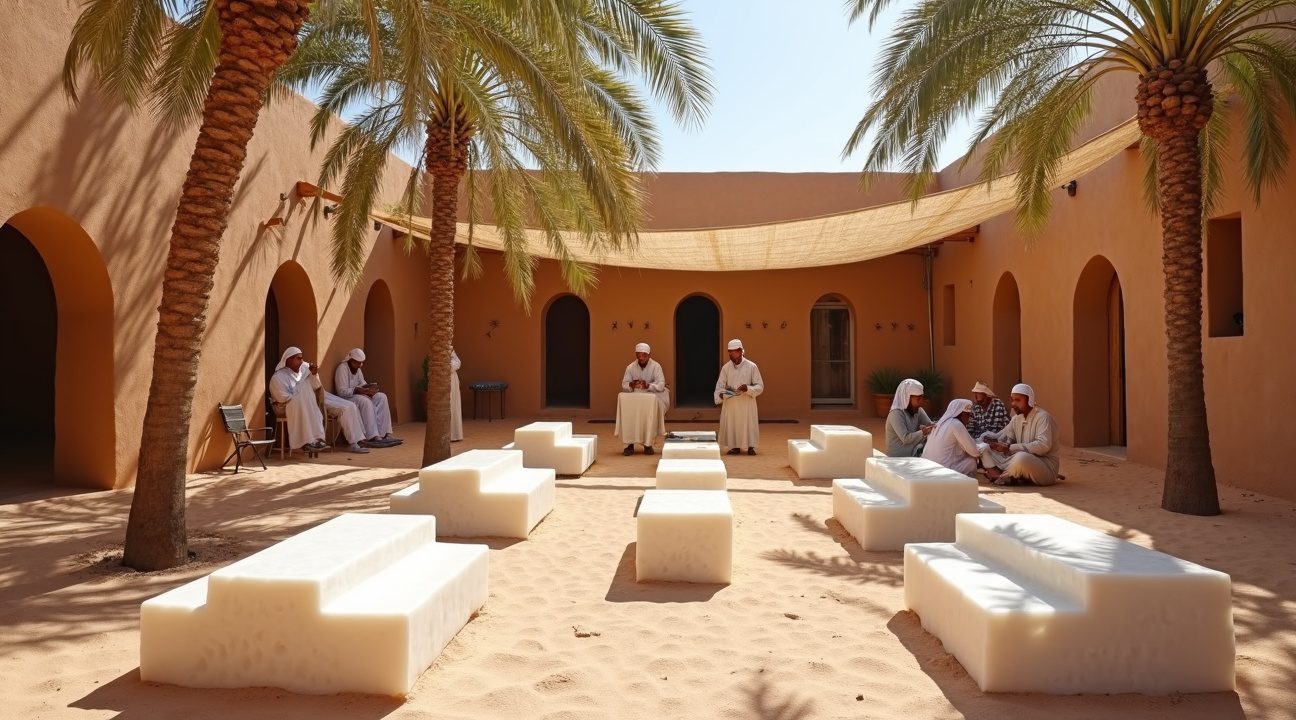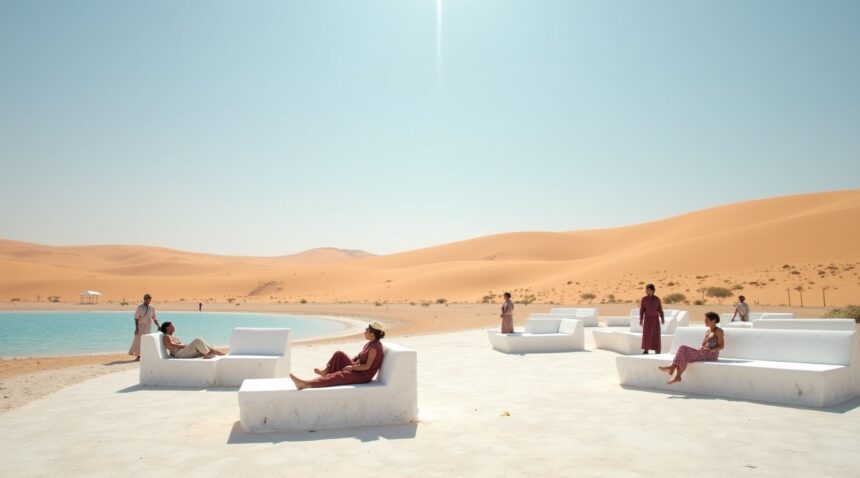Egypt’s Siwa Oasis has developed a remarkable desert cooling solution through salt crystal benches that maintain comfortable surface temperatures even when air temperatures soar above 40°C (104°F). These innovative seating installations utilize salt’s exceptional thermal conductivity and natural evaporative properties to create effective cooling zones in harsh desert environments. Local craftsmen continue traditions dating back millennia to transform saline lake deposits into functional furniture.
Key Takeaways
- Salt crystal benches actively draw heat away from the human body through superior thermal conductivity, creating a natural cooling effect that outperforms traditional desert seating materials like stone or palm matting.
- The benches offer built-in antimicrobial properties that inhibit bacterial growth, making them naturally hygienic for communal use in remote desert locations where regular cleaning is challenging.
- Local Siwa craftsmen extract salt blocks directly from mineral-rich lake shores using traditional techniques passed down through generations, supporting both cultural heritage preservation and a sustainable local economy.
- These cooling installations serve essential safety functions by helping prevent heat-related health issues for desert travelers, providing quick body temperature relief in extreme conditions.
- The tradition represents ancient Berber wisdom adapted for modern applications, demonstrating how communities can thrive in harsh climates through innovative use of locally available geological resources.
Siwa Oasis Salt Benches Stay Cool Even When Desert Temperatures Soar Above 40°C
I’ve observed something remarkable about salt crystal benches in Egypt’s desert rest zones – they maintain a surprisingly cool surface temperature even when the surrounding air blazes past 40°C (104°F). This extraordinary phenomenon isn’t magic; it’s pure physics at work.
How Salt’s Thermal Properties Create Natural Air Conditioning
Salt possesses exceptionally high thermal conductivity, which means it can rapidly absorb and dissipate heat from anything that touches it. When someone sits on these benches, the salt immediately begins drawing heat away from their body at an accelerated rate compared to traditional seating materials. This process happens so efficiently that the bench surface feels noticeably cool against the skin, even under the blazing desert sun.
The cooling effect becomes even more pronounced through ambient evaporation. Salt naturally draws moisture from the surrounding air, and this collected moisture enhances the heat extraction process from the human body. Think of it as a natural evaporative cooling system – the salt acts like a sponge that pulls both heat and moisture away from anyone using the bench, creating an amplified cooling sensation that provides genuine relief in extreme temperatures.
Built-in Hygiene Benefits for Desert Travelers
Beyond their cooling properties, these salt blocks offer natural antimicrobial benefits that make them ideal for communal use in harsh desert environments. Salt’s inherent ability to inhibit bacterial growth means these benches remain hygienic even with constant use by multiple travelers throughout the day. This characteristic proves particularly valuable in remote desert locations where traditional cleaning methods aren’t readily available.
Desert rest zones equipped with these salt benches have become essential stopping points for travelers crossing Egypt’s vast desert expanses. The combination of immediate cooling relief and natural sanitation makes them superior to conventional seating options in such extreme conditions. Modern innovations continue to build upon these ancient principles, with some installations incorporating massive construction projects that utilize similar thermal management concepts.
The practical benefits extend beyond comfort – these benches help prevent heat-related health issues by providing an effective way to lower body temperature quickly. For anyone traversing Egypt’s desert regions, finding one of these salt crystal rest zones can mean the difference between dangerous overheating and safe, comfortable travel through some of the planet’s most challenging environments.
https://www.youtube.com/watch?v=kVjA0mEah3s
How Local Craftsmen Transform Siwa’s Saline Lakes Into Desert Furniture
I’ve discovered that the ancient art of salt crystal furniture making in Siwa Oasis represents one of Egypt’s most fascinating examples of traditional craftsmanship meeting practical design. Local artisans extract salt blocks directly from the mineral-rich shores of Siwa’s saline lakes, transforming these natural formations into functional furniture pieces that serve desert communities across Egypt.
The extraction process itself requires considerable skill and knowledge passed down through generations. Craftsmen identify optimal salt deposits along the lake shores, selecting blocks with the right density and crystal structure for furniture production. They carefully remove these formations using traditional tools, ensuring the salt maintains its structural integrity during harvest. After extraction, workers transport the raw salt blocks to workshops where skilled artisans begin the shaping process.
Traditional Techniques Meet Modern Applications
Siwa’s craftsmen employ time-honored methods to transform raw salt into finished furniture pieces. The process involves several key steps that ensure both durability and aesthetic appeal:
- Cutting and shaping salt blocks using specialized tools designed for mineral work
- Smoothing surfaces through careful grinding and polishing techniques
- Creating joints and connections that allow for larger furniture assemblies
- Applying finishing treatments that enhance the salt’s natural cooling properties
- Quality testing to ensure each piece meets standards for long-term use
The resulting furniture includes not only benches but also tables, decorative elements, and architectural features that appear throughout local buildings and tourist accommodations. These pieces showcase the versatility of salt as a construction material while maintaining the distinctive aesthetic that defines Siwa’s architectural identity.
Continuous habitation since 2000 BC has allowed Siwa Oasis to preserve these ancient construction and craftsmanship traditions. This historical continuity ensures that modern craftsmen work with techniques refined over millennia, creating furniture that connects contemporary users with Egypt’s deep cultural heritage. The knowledge transfer from master craftsmen to apprentices maintains quality standards while allowing for subtle innovations that improve functionality.
The salt furniture industry significantly contributes to Siwa’s local economy by providing employment for skilled workers and generating income through both domestic and export sales. Local families often specialize in specific aspects of production, from extraction to finishing, creating a community-based manufacturing network that supports sustainable economic development. This traditional industry offers an alternative to more disruptive economic activities while honoring cultural practices.
Hotels and resorts throughout Egypt’s desert regions increasingly incorporate salt crystal furniture into their designs, recognizing both the practical cooling benefits and the authentic cultural appeal these pieces provide guests. The natural thermoregulatory properties make salt benches particularly valuable in outdoor spaces where conventional seating becomes uncomfortably hot under intense desert sun. Ambitious construction projects in desert environments often reference traditional cooling techniques when designing modern comfort solutions.
Export markets have expanded beyond Egypt as international buyers discover the unique properties of Siwa salt furniture. Desert regions worldwide, from the American Southwest to Australia’s interior, now feature these cooling furnishings in both residential and commercial applications. The durability of properly crafted salt furniture allows these pieces to withstand harsh environmental conditions while maintaining their cooling effectiveness.
The thermoregulatory properties that make salt crystal benches effective in Egypt’s desert rest zones stem from salt’s natural ability to absorb and dissipate heat. Unlike metal or plastic alternatives that retain heat throughout the day, salt furniture remains comfortable to touch even under direct sunlight. This characteristic, combined with salt’s antibacterial properties, makes these pieces ideal for public seating areas where hygiene and comfort are priorities.
Siwa’s craftsmen continue to refine their techniques while maintaining traditional methods that have proven effective over centuries. Modern tools occasionally supplement hand methods, but the fundamental approach remains unchanged, ensuring that each piece retains the quality and character that distinguishes authentic Siwa salt furniture from mass-produced alternatives.
Why Salt Benches Outperform Traditional Desert Seating Options
Salt crystal benches demonstrate remarkable advantages over conventional desert seating through their exceptional natural heat absorption properties. While date palm matting provides only moderate insulation and stone benches retain low to moderate heat levels, salt crystal formations actively draw heat away from the human body. This superior cooling mechanism stems from salt’s crystalline structure, which naturally regulates temperature through evaporative processes that create a consistently cool surface even during peak desert heat.
The production methods further distinguish salt benches from their alternatives. Local Siwa salt blocks serve as the primary material source, eliminating the need for imported resources that other seating options require. Date palm seating relies heavily on harvested palm materials, while stone benches often depend on either imported stones or specific local quarrying operations. This local sourcing approach reduces environmental impact while supporting regional economies.
Health and Durability Benefits
Salt crystal benches offer significant antimicrobial properties that traditional seating options cannot match. The natural mineral composition creates an environment hostile to bacteria and other microorganisms, providing users with inherently hygienic seating. Date palm matting and stone surfaces maintain neutral hygienic properties, requiring regular cleaning and maintenance to ensure sanitation standards.
Durability comparisons reveal salt benches’ exceptional longevity in harsh desert conditions:
- Date palm materials face constant threats from decay, insect damage, and weathering that significantly reduce their functional lifespan.
- Stone benches, while durable, can crack or shift due to temperature fluctuations and ground movement.
- Salt crystal benches resist these common forms of deterioration, maintaining structural integrity comparable to stone while offering superior functional benefits.
The aesthetic appeal of salt benches creates an iconic desert experience that enhances both cultural significance and practical utility. Their unique crystalline appearance reflects the natural mineral wealth of Egyptian desert regions, creating visually striking installations that complement the surrounding landscape. This distinctive look has made them popular features in rest zones, where they serve as both functional seating and cultural landmarks.
Recent installations demonstrate how salt benches integrate seamlessly into modern desert tourism infrastructure while preserving traditional cooling techniques. The combination of superior cooling performance, antimicrobial properties, and striking visual appeal positions salt crystal benches as the optimal choice for desert rest zones. Their ability to provide consistent comfort in extreme heat conditions, combined with minimal maintenance requirements, makes them particularly valuable for remote desert locations where regular upkeep proves challenging.

The Cultural Legacy Behind Siwa’s Salt Crystal Seating Tradition
Salt crystal benches represent far more than simple furniture in Siwa Oasis – they embody the cultural identity and resourcefulness of this desert community. These distinctive seating arrangements appear throughout homes and public rest spaces, serving as symbols of local heritage and practical adaptation to harsh desert conditions.
I find it fascinating how Siwa residents have transformed abundant salt deposits from their depression into functional furniture that defines their living spaces. Salt benches stand apart from other traditional desert furnishings like date palm mats and palm trunk carpentry, which primarily serve purposes of soundproofing, insulation, and space division. The salt seating creates a unique dual function that no other material can replicate.
Ancient Berber Wisdom in Modern Applications
The tradition of crafting furniture from salt blocks traces its roots deep into Berber customs, representing generations of sustainable living practices in arid environments. This cultural heritage demonstrates how ancient communities developed innovative solutions using locally available materials. The practice reflects a profound understanding of desert survival techniques that have been passed down through centuries.
Berber communities recognized early on that salt’s natural properties could provide relief from desert heat while serving structural purposes. Their knowledge of salt’s cooling effects when in contact with human skin has influenced architectural choices throughout the region. This wisdom continues to shape how modern Siwa residents approach climate adaptation in their daily lives.
The abundance of salt within the Siwa depression creates opportunities that few other desert communities possess. Local craftspeople have developed specialized techniques for selecting, cutting, and shaping salt blocks into furniture pieces that can withstand daily use. These skills require understanding both the geological properties of different salt formations and the structural requirements for functional seating.
Contemporary Siwa households often feature multiple salt benches strategically placed in areas where family members gather during the hottest parts of the day. Public rest spaces incorporate these cooling seats into their design, creating community gathering points that offer natural climate relief. The benches serve social functions beyond their cooling properties, becoming focal points for conversation and community interaction.
The sustainable aspect of salt bench production aligns with broader environmental consciousness that has always characterized desert communities. Unlike imported materials that require transportation across vast distances, salt blocks come directly from local deposits. This reduces environmental impact while supporting traditional craftsmanship skills within the community.
Salt crystal seating also connects Siwa residents to their geological landscape in ways that other furnishing materials cannot achieve. Each bench carries the unique mineral characteristics of its source location, creating furniture pieces that literally embody the land’s natural properties. This connection between material and place strengthens cultural identity while providing practical benefits.
The cooling properties of salt benches become particularly valuable during peak summer months when temperatures can become unbearable. Unlike conventional seating materials that absorb and retain heat, salt naturally draws warmth away from the body through its crystalline structure. This makes extended sitting periods comfortable even during midday heat.
Modern adaptations of the tradition have seen salt benches incorporated into tourist accommodations and cultural centers, introducing visitors to authentic Siwa living practices. These installations help preserve traditional knowledge while demonstrating practical applications of ancient wisdom. The benches often become conversation starters about sustainable living and cultural adaptation.
Local artisans continue to refine their salt-working techniques, developing new approaches to enhance durability and aesthetic appeal. Some craftspeople experiment with different salt formations to create varied textures and cooling intensities. Others focus on traditional methods that have proven effective over generations of use.
The cultural significance of salt crystal benches extends beyond their immediate practical applications. They represent successful adaptation to challenging environmental conditions using available resources. This tradition showcases how communities can thrive in harsh climates through innovative material use and cultural knowledge preservation. The benches continue to serve as tangible links between Siwa’s geological wealth and its cultural heritage, demonstrating sustainable living principles that remain relevant in contemporary desert communities.

Sources:
LabOasis — “Oasis in danger”
NASA Technical Report: “Desert Landforms of Southwest Egypt: A Basis for…”


